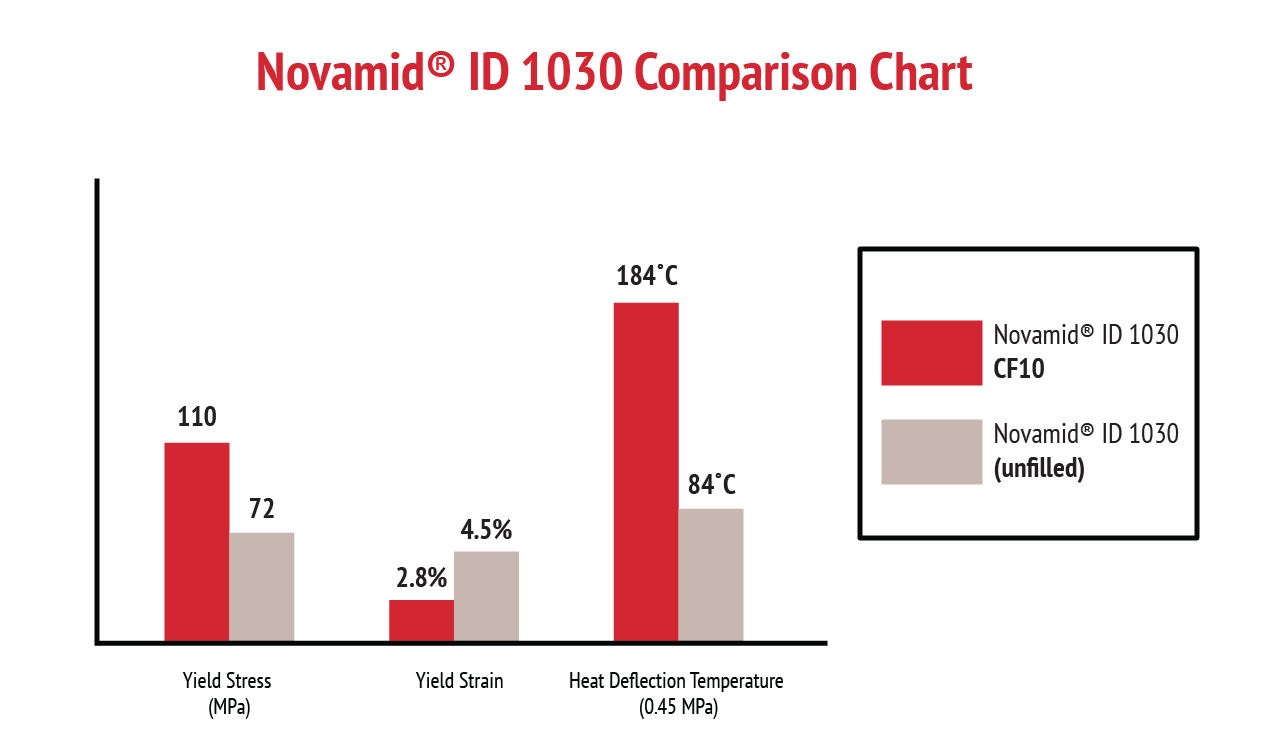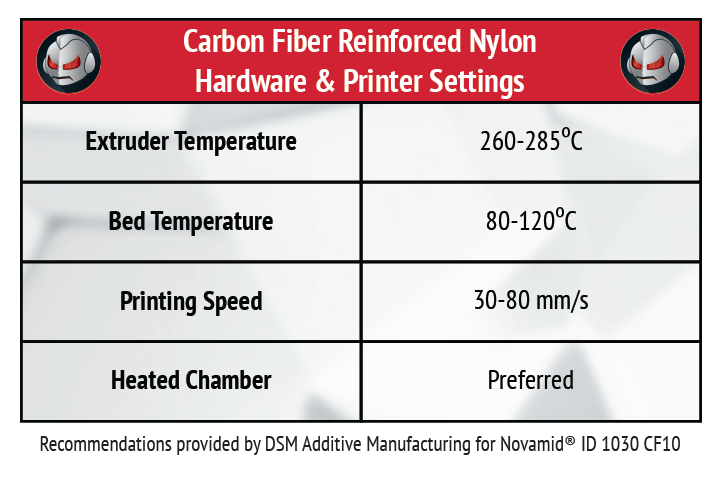Ready to find out more?
Drop us a line today for a free quote!
What is Carbon Fiber reinforced Nylon?
Nylons are a family of synthetic polymers composed of polyamides and are the material of choice for many demanding additive manufacturing applications. Nylons tend to be semi-crystalline and are available in different grades (PA6/6, PA6, PA12, etc.) when good mechanical strength, good stability under heat, and/or chemical resistance are required. Chopped carbon fiber may be added to Nylon in order to improve the materials properties, including strength, stiffness, and performance at elevated temperatures.
Carbon fiber reinforced Nylon filaments have become popular for 3D printing professionals wanting to make functional parts.

What applications use Carbon Fiber Reinforced Nylon?
Carbon fiber reinforced Nylons are great for 3D printing durable, structural parts with high dimensional stability. They can be ideal for a broad range of demanding applications, including:
- Industrial applications - masking fixtures, conveyor system components
- Orthotics and Prosthetics - Braces, sockets, inserts
- Transportation (Automotive, Off-road vehicle, motorbikes) – lever arms, air management components (ducts, tubes)
- Manufacturing jigs and fixtures
- Lightweight applications
- Protective and supporting sports gear and equipment
- Robotic tooling and end-of-arm tooling

Nylon CF PERFORMANCE FEATURES
Key benefits and properties of carbon fiber reinforced Nylon filament include:
- Low warpage compared to unfilled Nylon
- Durable parts with good mechanical properties and inter-layer strength
- Improved strength, stiffness, and heat resistance compared to unfilled Nylon
Nylon CF Material Properties
The following information is provided by Covestro (formerly DSM Additive Manufacturing) for 3D printed test samples of Novamid® ID 1030 CF10 (carbon fiber reinforced Nylon 6/66):
- Tensile modulus (X-X Direction): 7,625 MPa
- Stress at yield (X-X Direction): 112 MPa
- Strain at yield (X-X Direction): 2.5%
- Stress at break (X-X Direction): 110 MPa
- Strain at break (X-X Direction): 2.2%
- Tensile modulus (X-Y Direction): 2,720 MPa
- Stress at yield (X-Y Direction): 63 MPa
- Strain at yield (X-Y Direction): 3.0%
- Stress at break (X-Y Direction): 58 MPa
- Strain at break (X-Y Direction): 4.5%
Comparing molded test samples of Novamid® ID 1030 CF10 with it’s unfilled counterpart, you can see how the properties are improved by the inclusion of carbon fiber:
Yield Stress (MPa):
- Novamid® ID 1030 CF10 = 110
- Novamid® ID 1030 (unfilled) = 72
Yield Strain:
- Novamid® ID 1030 CF10 = 2.8%
- Novamid® ID 1030 (unfilled) = 4.5%
Heat Deflection Temperature (0.45 MPa):
- Novamid® ID 1030 CF10 = 184℃
- Novamid® ID 1030 (unfilled) = 84℃

Disclaimer: The above information is provided in good faith. JuggerBot 3D assumes no obligation or liability for the accuracy or completeness of the information supplied in this document. It is solely the customers responsibility to determine if the product and information in this document are appropriate for the customers end use. Responsibility for the use, storage, handling, and disposal of the products herein is that of the purchaser or end user.
FFF 3D Printer Requirements and Settings for Carbon Fiber Reinforced Nylon
In order to prevent moisture absorption, filament should be kept closed in undamaged packaging supplied. Partially used spools should be sealed before storing. Filament should be dried before use, and kept dry during jobs for best results. A heated chamber is recommended to achieve better dimensional and mechanical properties.

JuggerBot 3D’s printers are stand-alone and self-contained, incorporating a material dryer, an independently controlled loading bay, and environmentally controlled build chambers. Learn more by visiting our product page!
3D Printing with Nylon CF- the procedure
Covestro,formerly DSM Additive Manufacturing, provides suggested process guidelines for Novamid® ID1030 CF10, a carbon fiber-reinforced PA6/66 filament. For best results, operators should refer to the following:
- Drying: Use a desiccant dryer for 4 hours at 80°C / 176°F
- Extrusion: Extruder temperature should be between 260 - 285°C / 500-545°F.
- Heated print bed: Heated print bed (>100°C / >212°F), the optimum is 110°C / 230°F. Ensure good bed adhesion at time of print.
- Build chamber: A heated build chamber reduces the warpage and helps the fusion of the layers during printing. In this way the force is reduced and delamination from the build plate is less likely.
- Startup/shut down: Production has to start with a clean machine. Starting the machine, extrude at least 50 mm of new filament through the nozzle.
Contributor's Bio:
Greg Costantino is the New Business Development and Application Specialist at DSM Additive Manufacturing, a business unit of Royal DSM, NV. He is responsible for developing and executing the strategy for business development in the N. America region. Some of his key responsibilities are identification and analysis of markets for growth, strategic planning, project management and coordination of new product development.

Greg Costantino | New Business Development & Application Specialist | DSM Additive Manufacturing
DSM – Bright Science. Brighter Living.™
Royal DSM is a global science-based company active in health, nutrition and materials. By connecting its unique competences in Life Sciences and Materials Sciences DSM is driving economic prosperity, environmental progress and social advances to create sustainable value for all stakeholders. DSM delivers innovative solutions that nourish, protect and improve performance in global markets such as food and dietary supplements, personal care, feed, pharmaceuticals, medical devices, automotive, paints, electrical and electronics, life protection, alternative energy and bio-based materials. DSM’s 23,500 employees deliver annual net sales of around € 9 billion. The company is listed on NYSE Euronext.
